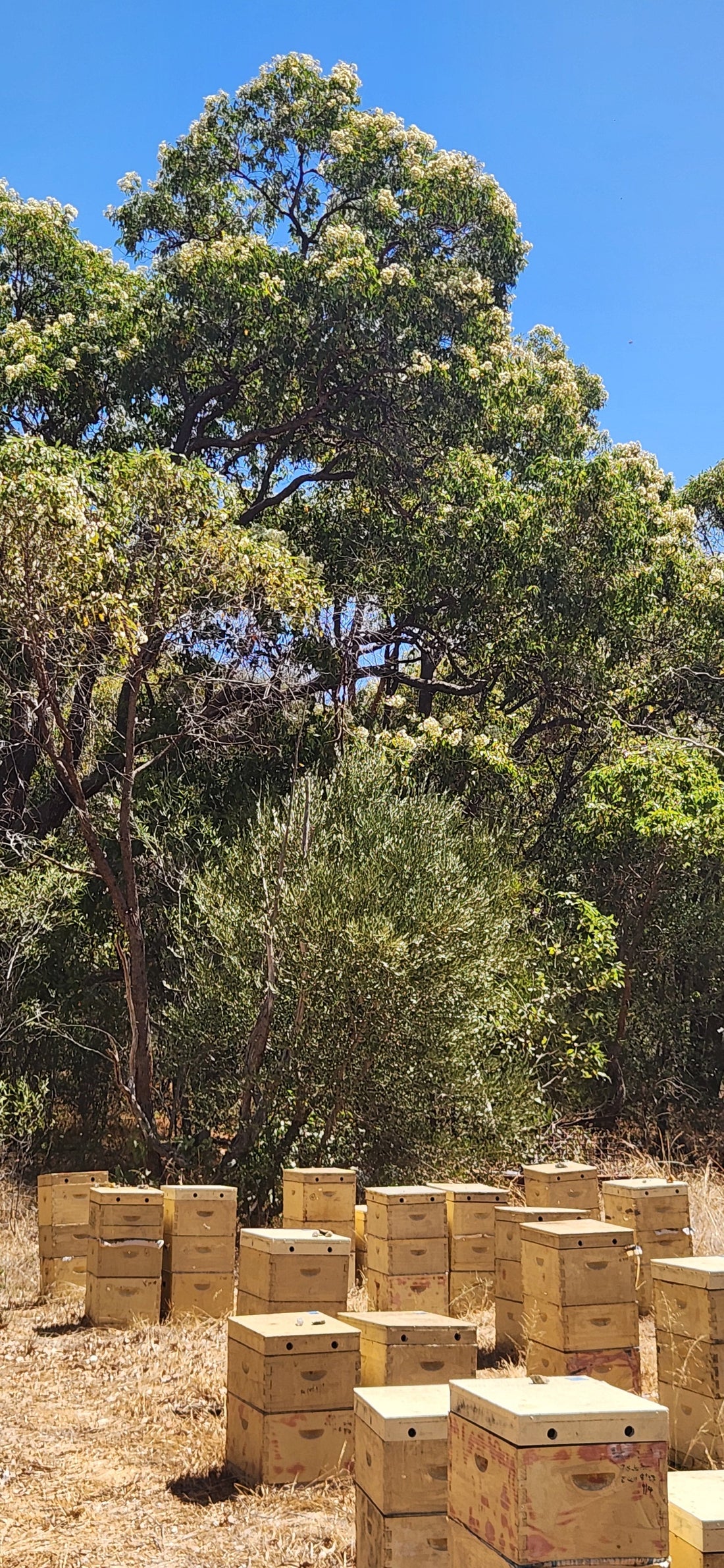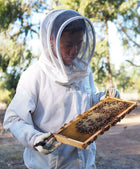Jarrah Honey – How TA Rating Differs from Manuka Honey’s UMF

Jarrah Honey: How TA Rating is Different from Manuka Honey’s UMF Rating
Jarrah honey – a rare Western Australian honey – is often compared to famed Manuka honey from New Zealand for its remarkable medicinal qualities. Yet each is assessed by a different activity rating: Jarrah by TA (Total Activity) and Manuka by UMF (Unique Manuka Factor). Understanding TA vs. UMF is key to grasping how these honeys are measured for purity and potency. In this guide, we break down what TA and UMF mean, how they differ, and why Jarrah’s TA rating shines. By the end, you’ll see how Jarrah honey’s lab-tested TA stacks up against Manuka’s UMF, helping you choose the best authentic honey for your needs.
What is Total Activity (TA) in Honey?
Total Activity (TA) is a rating that measures a honey’s overall antimicrobial strength – essentially how effective the honey is at killing bacteria and fungi. The TA number is determined by laboratory tests (often a phenol equivalence test) that gauge the honey’s ability to suppress bacteria. The higher the TA value, the greater the honey’s bacteria-fighting power. For example, a TA 30+ honey has very strong antibacterial activity, comparable to an antiseptic solution with 30% phenol.
Importantly, TA captures all of a honey’s antibacterial factors. In many Australian honeys like Jarrah, the main factor is natural hydrogen peroxide, which bees produce in the honey. This peroxide-based activity works broadly against microbes. Some honeys may also contain non-peroxide activity – additional antimicrobial compounds unique to certain floral sources. TA ratings account for both. In Jarrah honey’s case, it contains peroxide activity (PA) that is especially potent, as well as any minor non-peroxide factors, giving a full picture of its strength.
When you see a Jarrah honey labeled “TA 35+” or “TA 50+”, it means that honey’s total antimicrobial effectiveness is very high – a value confirmed by lab testing. Jarrah honey is frequently called a “healing honey” in Australia because of these high TA levels. Research confirms Jarrah’s robust germ-killing abilities. For instance, studies have found Jarrah honey can inhibit even antibiotic-resistant bacteria and disrupt biofilms (protective layers of germs), thanks to its strong peroxide activity. Jarrah’s TA rating effectively captures this broad-spectrum antimicrobial power in one number.
What is UMF in Manuka Honey?
Unique Manuka Factor (UMF) is a special grading system exclusively for Manuka honey, which is produced by bees pollinating the Manuka bush in New Zealand. Unlike TA, which is a general measure, UMF is a trademarked rating focused on one particular component: the non-peroxide activity (NPA) of Manuka. Manuka honey gained fame for containing methylglyoxal (MGO), a compound not found in most honeys, which gives Manuka an extra antibacterial punch beyond typical peroxide effects. UMF correlates largely with the level of MGO and other non-peroxide factors in the honey.
In simpler terms, UMF measures the strength of Manuka’s unique antibacterial ingredient. A higher UMF means more of those Manuka-specific compounds are present and thus greater ability to kill bacteria. Manuka honey is commonly sold in grades like UMF 10+, 15+, 20+, etc. For example, UMF 10+ roughly corresponds to MGO ~263 mg/kg, and higher UMF like UMF 20+ corresponds to MGO levels above 800 mg/kg. These ratings are certified by the UMF Honey Association to assure consumers of authenticity and potency.
Because UMF targets the non-peroxide activity, it doesn’t account for ordinary peroxide-based effects (which Manuka also has, though relatively weaker). It’s a partial measure of antimicrobial power, but very useful for comparing Manuka batches. Notably, UMF and MGO ratings apply only to Manuka honey – you won’t see a UMF rating on Jarrah or other honeys from outside New Zealand.
One practical point: high UMF Manuka honeys (UMF 20+ or UMF 25+) are extremely potent. Some experts even recommend that Manuka honey above UMF 15 be used sparingly or for specific therapeutic use, while lower UMF (5 to 15) is suitable for regular consumption. This guidance exists because very high MGO content, while great for killing bacteria, is a powerful bioactive that one might not want to ingest in large daily quantities. Manuka in the UMF 5–15 range is popular as a daily wellness honey, whereas UMF 20+ is often reserved for medical grade applications (wound care, etc.).
TA vs. UMF: Key Differences
To sum up, Total Activity vs. Unique Manuka Factor – what’s the difference? Here are the key points:
-
Scope of Activity Measured: TA is broad-spectrum, reflecting all antibacterial activity in the honey (peroxide and any non-peroxide factors). UMF is specific, measuring only the non-peroxide activity unique to Manuka honey. In Jarrah honey, which lacks Manuka’s MGO, the TA primarily represents its hydrogen peroxide activity.
-
Usage and Exclusivity: TA ratings are used for honeys like Jarrah (and a few other Australian honeys such as Marri) that demonstrate significant medicinal activity. UMF ratings are used only for genuine Manuka honey from New Zealand. Other honeys cannot be labeled with UMF. Jarrah honey jars will typically show a TA number, while Manuka jars show UMF (or sometimes MGO) on their labels.
-
Numerical Scale: TA and UMF scales are not identical, so a number in one doesn’t directly equal the other. Generally, Jarrah honey TA values can run very high – often TA 20+ to 30+ for good medicinal-grade Jarrah, with top batches reaching TA 50+. Manuka honey UMF values usually range from UMF 5+ up to about UMF 20–25, with anything above UMF 25 being rare and exceptionally potent. One study comparing analytical profiles noted that Jarrah honey with TA 50+ exhibited an antimicrobial strength roughly equivalent to MGO 4000+ – far beyond typical Manuka MGO levels. In practice, this means a top-tier Jarrah can match or exceed the bacteria-fighting ability of the strongest Manuka, albeit via a different mechanism.
-
Chemical Basis: Jarrah’s TA is largely due to hydrogen peroxide generated by enzymes when bees make the honey. Manuka’s UMF comes from methylglyoxal (and related compounds) derived from the Manuka nectar. Each works differently: peroxide is a broad antiseptic that many honeys have to some degree, while MGO is a stable compound unique to Manuka. Interestingly, Jarrah honey has been found to contain both peroxide activity and some non-peroxide factors, but the peroxide effect is much stronger in Jarrah. Manuka also has some peroxide activity, but its claim to fame is the MGO/NPA component measured by UMF.
-
Health Implications: Both Jarrah and Manuka are powerful medicinal honeys, but their use cases can differ. Manuka (especially high UMF) is renowned for topical use on wounds and infections due to its potent stable antibacterial action. Jarrah’s high TA makes it similarly useful for wound care – in Western Australia some hospitals have used Jarrah-based dressings, just as Manuka dressings are used in New Zealand. For daily dietary use, Jarrah’s peroxide-based activity is very effective yet gentle, and Jarrah also boasts additional perks like a lower glycemic index than Manuka or common table honey. (Jarrah’s higher fructose content gives it a GI in the low 50s, whereas typical honeys are around 60+.) This means Jarrah causes a slower rise in blood sugar, a bonus for health-conscious consumers. Manuka honey, while not particularly low-GI, is often taken in small doses for immunity or digestive benefits.
In essence, TA and UMF are two sides of the same coin – both tell us how “active” a honey is – but TA provides a combined activity rating (ideal for Jarrah’s broad action), whereas UMF zeroes in on a single ingredient (ideal for standardizing Manuka quality).
Why Jarrah’s TA Rating Shines
For those seeking a potent natural remedy honey, Jarrah honey’s high TA rating is a mark of quality and efficacy. Jarrah honey is sometimes dubbed “Australia’s liquid gold,” and its TA is a big reason why. Many Jarrah honey benefits align with those of Manuka – from soothing sore throats and coughs to aiding wound healing – thanks to its strong antibacterial and antifungal properties. In fact, Jarrah is often mentioned alongside Manuka in terms of medicinal prowess. A 2023 analysis confirmed Jarrah honey is exceptionally rich in phenolic antioxidants, which not only contribute to health benefits but may synergistically enhance its antimicrobial effect. Jarrah’s TA rating captures all these synergistic effects.
Another advantage of Jarrah honey is that it tends to stay liquid longer and resist crystallisation. This is due to its natural sugar ratio (higher in fructose), and interestingly, high-TA Jarrah honey almost never granulates in the jar. Bee keepers in Western Australia even use “does not crystallise” as a sign of authentic Jarrah with very high activity. This means a good Jarrah honey remains pourable and easy to use over time without needing re-warming – a nice practical perk. (Manuka honey, by contrast, often has a thick, gel-like consistency and can crystallise, though slower than some common honeys.)
From a taste perspective, Jarrah honey is well-loved for its smooth, full-bodied flavor with caramel notes, making it not just a “medicine” but a delicious everyday honey. Many Singaporean consumers enjoy Jarrah as a healthier sweetener – drizzling it on foods or stirring into drinks – to get both taste and wellness benefits. The low GI combined with high TA is a unique selling point of Jarrah honey in Singapore, where savvy shoppers look for foods that support health. It’s no surprise that Jarrah honey has been gaining popularity locally as an alternative to Manuka.
Choosing Quality Honey: TA, UMF and Trust
Whether you opt for a Jarrah TA30+ or a Manuka UMF15+, the key is to buy from a trustworthy source that provides genuine, unadulterated honey. Unfortunately, honey fraud exists – a cheap “Manuka” or “Jarrah” at an unbelievable price may be fake or diluted. Here in Singapore, consumers value quality and authenticity. A good practice is to look for lab-tested honey with clear ratings on the label (TA, UMF or MGO) and transparent origin information. Reputable brands will share lab results or quality certifications to back their claims. For example, certified Manuka honey will carry an official UMF or MGO rating stamp, and high-grade Jarrah honey often comes with a lab-issued TA certificate of analysis.
Bee Bee Natural in Singapore is one such provider of authentic, lab-certified Jarrah honey. (In fact, our limited edition Jarrah honey was tested at an astonishing TA 63+ – far above the usual 35% benchmark – and we proudly share those results.) We harvest our Jarrah directly from Western Australian forests and test each batch’s TA level, so customers know they’re getting the real deal. By choosing a trusted source like Bee Bee Natural – which practices ethical beekeeping and transparent labelling – you can enjoy all the benefits discussed here with confidence in the product’s purity.
In conclusion, Jarrah honey’s TA vs. Manuka honey’s UMF comes down to different measures for two incredible honeys. Jarrah’s TA rating showcases its broad-spectrum antimicrobial might (and often superior total activity), while Manuka’s UMF highlights a singular antibacterial factor that made it world-famous. Both honeys can be wonderful allies for your health, from fighting germs to supplying antioxidants. If you’re in Singapore looking for a potent yet smooth everyday honey, Bee Bee Natural's Jarrah honey – with its extreme high TA, low GI sweetness and trusted provenance – is definitely worth a try. And if you’re a Manuka fan, understanding UMF helps you pick the right grade for your needs. Ultimately, knowledge of these ratings ensures you get maximum goodness in every jar, be it TA or UMF – and that is sweet news for honey lovers!



